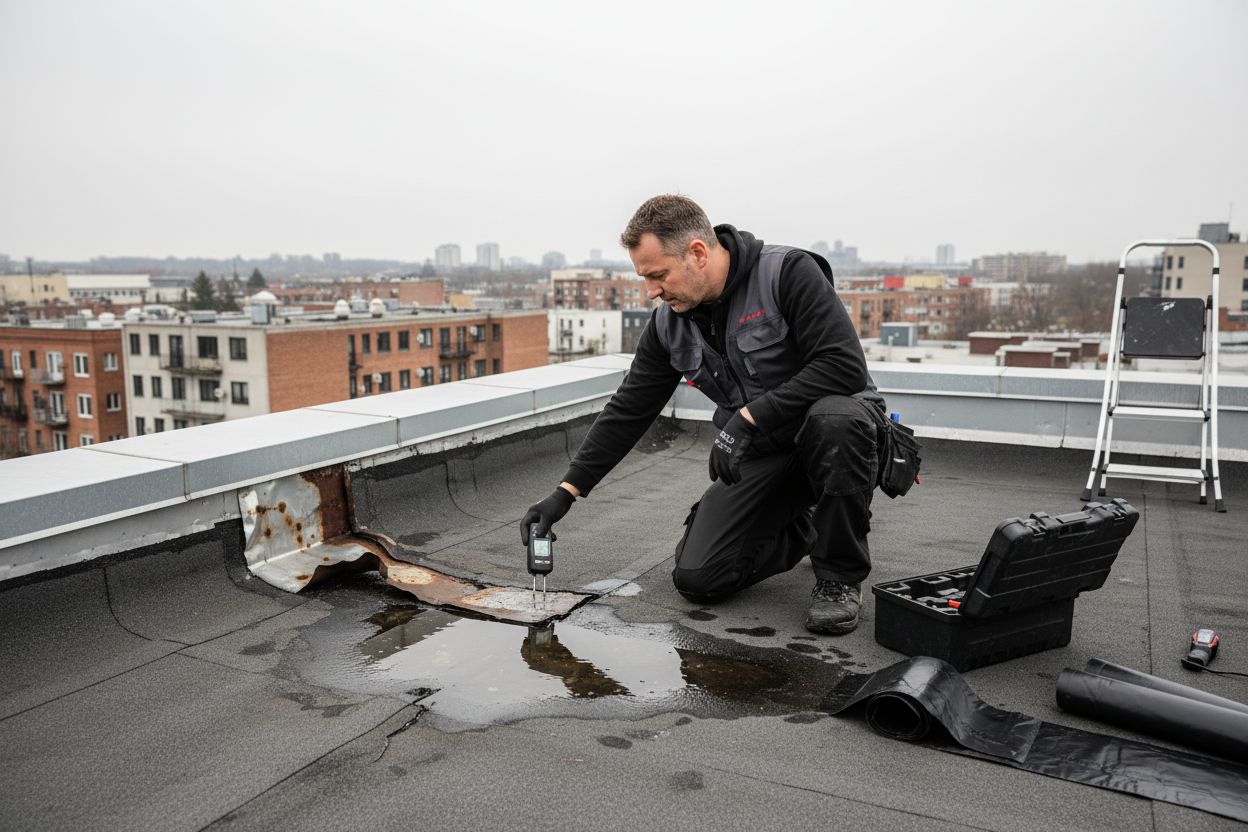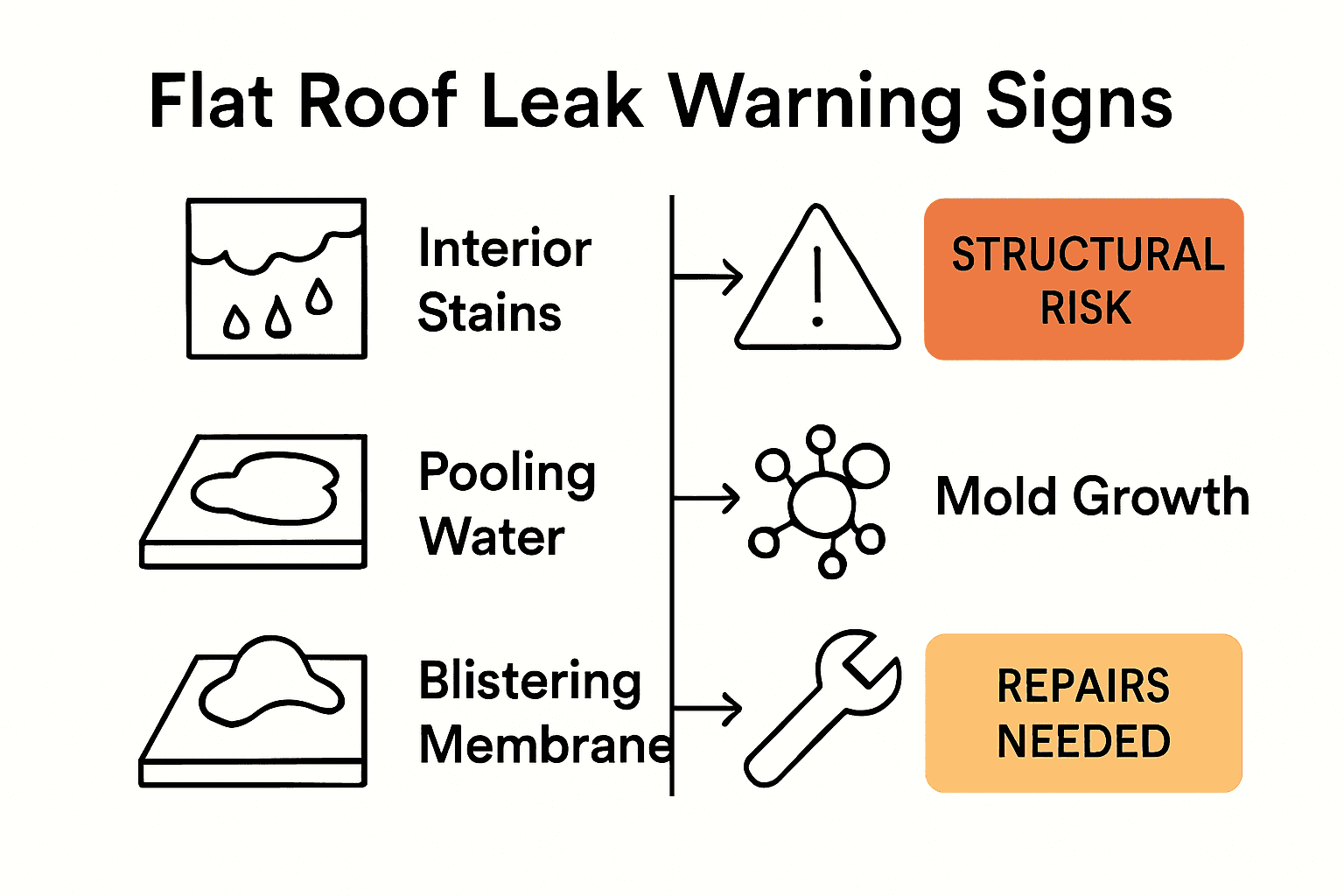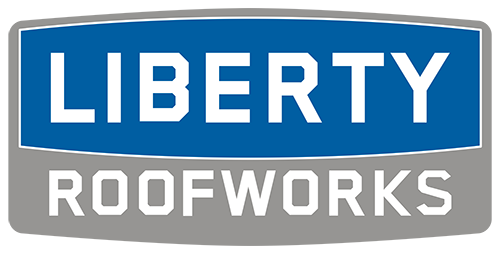Did you know that over 80 percent of commercial buildings rely on flat roofs for their unique blend of function and style? The popularity of these roofing systems comes from their ability to maximize usable space, but they also face distinct risks from water damage and leaks. Knowing how flat roofs work, the materials used, and common signs of trouble helps property owners protect their investments and avoid costly repairs.
Key Takeaways
| Point | Details |
|---|---|
| Flat Roof Benefits | Flat roofs maximize usable space, are cost-effective, and provide potential for rooftop installations. |
| Common Leak Causes | Leaks typically arise from standing water, damaged flashing, and seam failures, necessitating vigilant maintenance. |
| Material Selection | Choosing the right roofing material is crucial for durability, with various options presenting unique risks and advantages. |
| Proactive Maintenance | Regular inspections and timely repairs are essential for preventing leaks and extending the lifespan of flat roofs. |
Table of Contents
- What Are Flat Roofs And How They Work
- Common Causes Of Flat Roof Leaks
- Types Of Flat Roofing Materials And Risks
- Warning Signs Of Flat Roof Water Damage
- Effective Solutions And Leak Prevention Strategies
What Are Flat Roofs and How They Work
Flat roofs are horizontal or near-horizontal roof structures with a minimal pitch of up to approximately 10 degrees. Flat roofing systems are most commonly found on commercial buildings, warehouses, and some modern residential structures, offering unique advantages in architectural design and space utilization. According to research from Wikipedia, these roofing systems are typically constructed with specialized waterproofing membranes installed over a sturdy structural deck.
The core functionality of flat roofs revolves around their strategic design. Unlike traditional sloped roofs, flat roofs provide several distinctive benefits:
- Maximizing usable interior space
- Enabling potential rooftop installations like solar panels or green spaces
- Cost-effective construction compared to pitched roofs
- Easier maintenance and accessibility
However, flat roofs come with specific engineering challenges. Flat roof designs require precise waterproofing and advanced drainage systems to counteract inherent risks like water ponding and wind uplift. Professional installation is crucial, as even a slight miscalculation in slope or membrane application can lead to significant water infiltration problems. Modern flat roof systems employ sophisticated materials like bitumen, single-ply membranes, metal coverings, and fiberglass-reinforced plastic (GRP) to ensure long-term performance and durability.
Common Causes of Flat Roof Leaks
Flat roofs are notorious for developing leaks due to several critical structural vulnerabilities. According to research from The Flat Roof Pros, these roofing systems are particularly susceptible to water infiltration from multiple complex factors. Standing water remains the primary culprit, which occurs when inadequate drainage allows moisture to accumulate and gradually compromise the roofing membrane.
The most prevalent causes of flat roof leaks include:
- Damaged Flashing: Deteriorated metal or plastic edging around roof penetrations
- Material Degradation: Aging membranes that crack, blister, or delaminate
- Thermal Movement: Repeated expansion and contraction causing structural stress
- Seam Failures: Weak points where roofing materials overlap or connect
- Punctures and Mechanical Damage: From foot traffic, dropped tools, or environmental impacts
Roof leak repair experts emphasize that professional installation and regular maintenance are crucial in preventing these issues. Poor initial design, substandard materials, and neglected inspections can transform minor vulnerabilities into significant structural problems. The complexity of flat roof systems means that even small defects can rapidly escalate into extensive water damage, potentially compromising the entire building’s structural integrity.

Types of Flat Roofing Materials and Risks
Flat roof systems utilize a diverse range of materials, each with unique performance characteristics and potential vulnerabilities. According to research from Wikipedia, these materials range from traditional to modern technologies, offering property owners multiple options for protecting their structures. Roofing membrane selection becomes critical in determining long-term durability and leak resistance.
The primary flat roofing materials include:
Here’s a comparison of common flat roofing materials and their key characteristics:
| Material | Advantages | Common Risks |
|---|---|---|
| Built-Up Roofing (BUR) | Affordable Good protection |
Heavy Prone to blisters |
| Modified Bitumen | Flexible Easy repairs |
UV damage Seam failures |
| EPDM (Thermoset) | Superior weather resistance Flexible |
Shrinking Punctures |
| TPO/PVC (Thermoplastic) | Heat-welded seams Energy efficient |
Seam splits Fires |
| Metal Panels | Durable Long lifespan |
Expensive Denting |
| GRP (Fiberglass) | High durability Waterproof |
Complex install Costly |
- Built-Up Roofing (BUR): Traditional layered system using felt and bitumen
- Modified Bitumen: Combines traditional and modern roofing technologies
- Thermoset Membranes: EPDM with excellent weather resistance
- Thermoplastic Membranes: TPO and PVC with strong heat-welded seams
- Metal Panels: Durable but potentially expensive
- Glass Reinforced Plastic (GRP): Highly resilient but complex to install
Flat roof repair experts emphasize that each material presents unique risks. Thermoset membranes like EPDM offer superior flexibility and weathering resistance, while thermoplastic options provide robust seam connections. The choice depends on factors including climate, building use, budget, and anticipated maintenance requirements. Understanding these material characteristics helps property owners make informed decisions about their roofing systems, balancing initial installation costs with long-term performance expectations.
Warning Signs of Flat Roof Water Damage
Water damage in flat roofs can be insidious, often developing silently before becoming catastrophically visible. According to research from CB Roofing, early detection is crucial in preventing extensive structural deterioration. The most immediate indicators involve interior signs like water stains on ceilings and walls, which suggest moisture has already penetrated your building’s protective barriers.
The key warning signs of flat roof water damage include:
- Interior Water Stains: Discoloration on ceilings or walls
- Mold and Mildew Growth: Indicating persistent moisture intrusion
- Visible Roof Surface Anomalies: Blistering, delamination, or seam failures
- Pooling Water Depressions: Permanent low spots collecting water
- Gutter and Drainage Issues: Clogged or detached drainage systems
- Unusual Thermal Signatures: Unexpected warmth or steam from roof surfaces
Roof inspection professionals recommend periodic assessments to catch these warning signs early. Some subtle indicators like dirt rings, discoloration, or minor surface irregularities might seem insignificant but can signal developing water infiltration problems. Proactive property owners understand that addressing these early symptoms can prevent costly structural repairs and potential interior damage, making regular roof monitoring a critical maintenance strategy.

Effective Solutions and Leak Prevention Strategies
Addressing flat roof leaks requires a comprehensive and strategic approach. According to research from The Flat Roof Pros, successful leak prevention hinges on proactive maintenance and professional intervention. Roof integrity demands a multi-faceted strategy that tackles both immediate repairs and long-term structural protection.
Key solutions and prevention strategies include:
- Drainage Optimization: Redesigning roof slopes and clearing drainage systems
- Flashing Repair: Replacing or resealing damaged metal or membrane edging
- Membrane Maintenance: Patching blisters, resealing seams, and addressing material degradation
- Professional Inspections: Regular comprehensive assessments of roof condition
- Material Upgrades: Using high-quality, durable roofing membranes
- Timely Interventions: Addressing minor issues before they escalate
Understanding roof leak repairs is crucial for property preservation. Professionals recommend a holistic approach that combines immediate problem-solving with preventative maintenance. This means not just fixing visible damage, but also implementing systemic improvements like enhanced drainage, proper material selection, and routine professional inspections. By treating your flat roof as a dynamic system requiring ongoing care, you can significantly extend its lifespan and prevent costly water damage.
Restore Confidence in Your Flat Roof with Trusted Solutions
If you have ever faced water stains, pooling, or the stress of hidden leaks on your flat roof, you know how quickly small issues can become major headaches. Flat roofs demand careful installation, routine inspections, and expert leak repairs to prevent costly damage. After reading this guide, you now understand the risks of damaged membranes, failed seams, and poor drainage that can threaten your building’s safety and value.
Do not let worry about water damage disrupt your life or business. At Liberty Roofworks, our experienced team specializes in both residential and commercial flat roof leak repairs and replacements. We use advanced materials such as EPDM and TPO, and we know exactly how to spot early warning signs before they turn into serious problems. Start with a professional roof inspection and enjoy peace of mind with solutions built for long-term protection. Visit Liberty Roofworks today to schedule your expert consultation and take the first step to a dry, safe flat roof. If you want to know more about our roof inspections or explore details about flat roof repairs, our team is ready to support you now.
Frequently Asked Questions
What are the common causes of flat roof leaks?
Common causes of flat roof leaks include damaged flashing, material degradation, thermal movement, seam failures, and punctures or mechanical damage. Standing water is also a primary issue, leading to compromised roofing membranes.
How can I prevent leaks in my flat roof?
To prevent leaks, focus on optimizing drainage, repairing flashing, maintaining roofing membranes, scheduling professional inspections, and using high-quality materials. Regular maintenance can help identify minor issues before they escalate into significant problems.
What are the warning signs of water damage in flat roofs?
Warning signs of water damage in flat roofs include interior water stains on ceilings or walls, mold and mildew growth, visible surface anomalies like blistering, pooling water, gutter and drainage issues, and unusual thermal signatures from the roof surface.
What types of materials are used for flat roofing?
Common materials for flat roofing include Built-Up Roofing (BUR), modified bitumen, EPDM (thermoset), TPO/PVC (thermoplastic), metal panels, and fiberglass-reinforced plastic (GRP). Each material has unique advantages and risks associated with its use.
